Eight rare juices you can only try in the Amazon
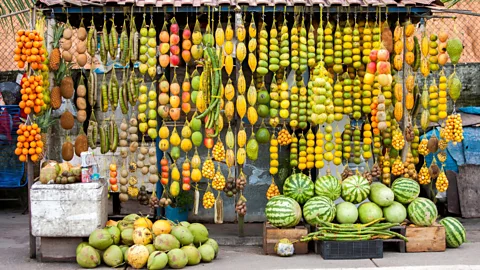 Alamy
AlamyFar from smoothie bars and powdered sachets, these wild Amazonian juices are pulped just hours after picking – making them rich in flavour and cultural meaning.
The Amazon is not only the world's largest and most biodiverse ecosystem – it's also one of the most delicious. Among the thousands of native species, around 220 trees are known to bear edible fruit, many of which never leave the jungle. Some are too delicate to export, while others are little known beyond the communities that have nurtured them for generations. But along the Amazon River and its tributaries – from Peru's misty highland jungle to the floodplains of northern Brazil – travellers can find market stalls and cafe counters brimming with thick, vibrant juices that capture the flavour of the forest.
These are the fruits you're unlikely to find bottled or powdered at home, often pulped just hours after harvest, served chilled in the tropical heat and prized not only for their nutrients but for their rich textures and sharp tangs.
Here are eight juices worth seeking out, whether for their bold flavours, cultural significance or the thrill of trying something new.
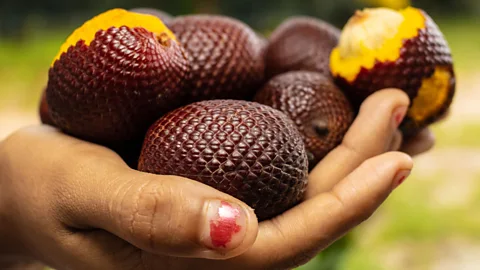 Getty Images
Getty ImagesAguaje
On the eastern slopes of the Andes, where rivers cascade in dramatic waterfalls into the Amazon Basin, travellers will find the aguaje fruit of the Moriche palm. In the small Peruvian city of Tingo Maria, markets are piled high with silver trays of the armadillo-like fruit. Locals soak them in water for a day or two, before peeling the brown armour to reveal an intensely orange flesh. The pulp is soaked, mashed and transformed into aguajina – a thick and custardy drink that tastes like cross between pumpkin pie and flan.
World's Table
BBC.com's World's Table "smashes the kitchen ceiling" by changing the way the world thinks about food, through the past, present and future.
Some locals say that the fruit contains oestrogen compounds and men should be careful of drinking too much of it, though there is little scientific evidence. "The aguajina is very useful – for the bone, for the skin, for the complexion – especially for women," says Gianina Pujay, an aguajinera who sells the drink across from Tingo Maria's fruit market.
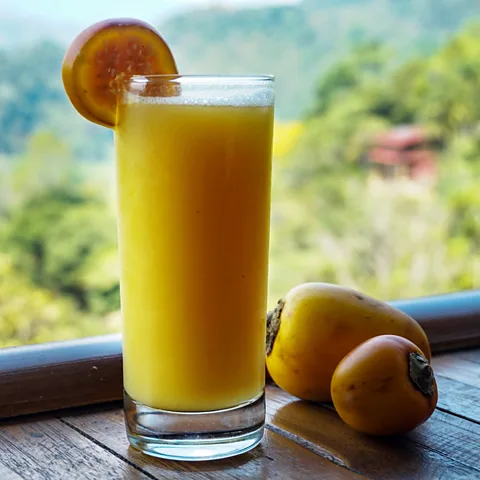 Nic Stevens
Nic StevensCocona
In the same region, the cocona fruit, a tropical relative of the common tomato, yields a tangy juice that tastes like a pineapple-papaya hybrid with a thick, almost oily body.
"Many Amazonian fruits are consumed in juice form because their pulp is acidic, fibrous or difficult to eat raw, like the cocona," explains Miluska Carrasco, a researcher and nutritionist at Peru's Instituto de Investigación Nutricional, "It's also a practical way to use them quickly before they spoil."
 Alamy
AlamyCamu camu
Descending from the verdant slopes of the Andes into the Amazon Basin, the rivers slow down and transform into thoroughfares of commercial activity. On the banks of the Ucayali River is the river port city of Pucallpa, the furthest Peru's road system will take you into the centre of the Amazon. Here, where container barges, passenger ships and canoes all move goods around the forest, camu camu is a must-drink juice.
The small, tart, plum-like fruit tastes like a sour strawberry with a hint of peach, and is a favourite of local juice vendors. "[It] has more vitamin C than oranges," says Carrasco, "[as well as] other bioactive compounds." Where a navel orange provides about 6mg of vitamin C per 100g, the camu camu contains more than 2,000mg for the same amount of flesh.
The season for camu camu is short, however, typically between January and March, so take advantage of the fresh juice when it's available. Locals also eat the little plums with salt; just spit out the seeds.
 Alamy
AlamyTucumã
In the heart of Brazil's vast Amazonas state, 700 miles east of Pucallpa as the toucan flies (and at least a week or more on a river boat), tucumã palms provide an orange fruit that's only in season from February to August. During this time, it's often eaten for breakfast with cassava flour and is a key ingredient in the state's signature x-caboquinho sandwich, where slices are layered with salty coalho cheese and sweet chunks of fried plantains.
To make juice from the notoriously fibrous tucumã, vendors use peelers, blenders and sieves to reduce shavings of the fruit to a pulp and then filter out the lightly nutty liquid.
According to Francisco Falcão, a farmer in the community of Bom Jesus in the Tefé National Forest, "people say that tucumã is good to eat and improves sight and skin". Indeed, the fruit is rich in both manganese and calcium. Where kiwi, which is relatively high in calcium, contains around 30mg of calcium per 100g, tucumã has been measured to contain around four times as much.
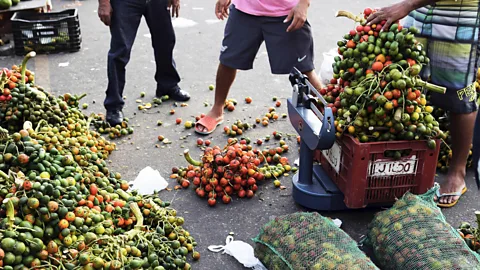 Alamy
AlamyPupunha
Also in the Tefé region, "there's a palm tree that people eat the fruit of," says Falcão. "Pupunha is a plant that we harvest starting in December and ending February." Spanish-speaking parts of the Amazon know this oily palm fruit as pejibaye or pijuayo, and it is a key source of natural fats as well as vitamin B1 and vitamin E.
The pupunha grow in clusters of orange and red acorn-shaped fruit. They cannot be eaten raw, but once boiled they make a filling snack akin to an oily sweet potato. The boiled fruits also produce a creamy orange juice once fully pulped. In Peru, forest communities ferment the pulp into a lightly alcoholic drink called chicha or masato – especially during times of harvest.
 Getty Images
Getty ImagesCupuaçu
In Manaus, capital of the Amazonas, reliable refrigeration means locals and visitors can enjoy fruits in various forms. The thick shell of the cupuaçu contains a collection of seeds surrounded by a fleshy white pulp. That pulp can be transformed into silky, tangy juice. But lately, locals have been incorporating its juice into ice cream. Indeed, the rest of Brazil is catching on, with ice cream parlours in Rio de Janeiro now offering the flavour too.
Cupuaçu tastes like a creamy pineapple – surprising given that it's a close relative of cacao. "It's the same genus as cacao and people make cupulate [as opposed to chocolate from it]," says Daniel Tregidgo, a researcher at Brazil's Mamirauá Institute for Sustainable Development. "When you go to the markets there are huge piles of cupuaçu seeds. I look at that and I say that's hipster chocolate right there."
Why haven’t we heard of cupulate yet? In Tregidgo's opinion, "It's a matter of investment. If you take something from the middle of Amazon and you try to get it out into the global market without being exploitative, it is a bit tricky." Bars produced from cupuaçu have the flavour of chocolate but retain some of their citrus piquancy.
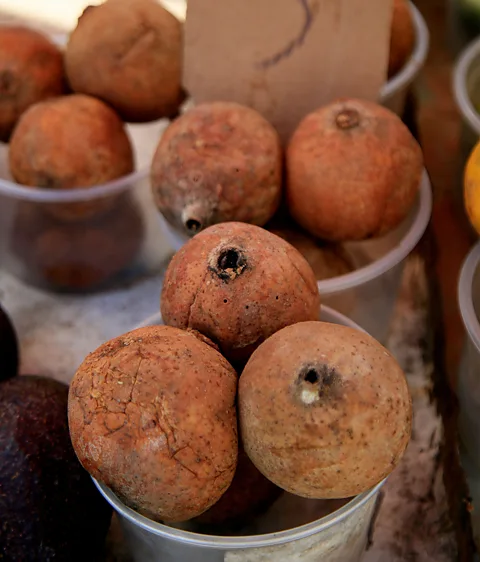 Alamy
AlamyJenipapo
In the Amazon delta, jenipapo is known for its traditional use as a blue dye and a temporary tattoo ink. The fruit itself, which grows all along Brazil's coast in addition to the Amazon, has a yellowish pulp that's a great source of vitamin B1 and zinc.
While jenipapo can be consumed as a fresh juice that tastes a bit like dried apricots, try ordering licor de jenipapo, an infused cachaça liqueur served in small bars and botecos.
 Alamy
AlamyAçaí
While açaí has become a global wellness trend, the version served in the Amazon bears little resemblance to the frozen bowls found abroad.
What many travellers don't realise is that there are seven distinct açaí palm species. Locals distinguish between açaí-do-Pará, açaí-do-mato and juçara, depending on region. In Belém, for example, vendors use pneumatic presses to extract the berry's thick, purplish pulp – sold in clear bags and consumed straight out of bowls with spoons, as if a purple gazpacho. Outside of its natural range in Brazil, the rest of the country enjoys the pulp prepared in yogurts and ice creams.
--
If you liked this story, sign up for The Essential List newsletter – a handpicked selection of features, videos and can't-miss news, delivered to your inbox twice a week.
